Legal Aspects of Contracts: UK Law, Case Studies and Torts
VerifiedAdded on 2019/12/03
|11
|3637
|330
Report
AI Summary
This report delves into the legal aspects of contracts within the UK legal framework. It begins by outlining the essential elements of a valid contract, such as offer, acceptance, consideration, and the intention to create legal relations, supported by relevant case law. The report then explores different types of contracts prevalent in the UK, including face-to-face, distance, and written contracts. Furthermore, it analyzes the elements of the tort of negligence, including duty of care, breach of duty, injury, proximate cause, and monetary loss, alongside possible defenses. The report contrasts the nature of liability in contract and tort, highlighting the differences in their origins and objectives. It also examines the neighbor principle and the concept of duty of care, referencing the landmark case of Donoghue v Stevenson, and concludes with a discussion of vicarious liability in cases of negligence, supported by cited case law, specifically in the context of employer liability.
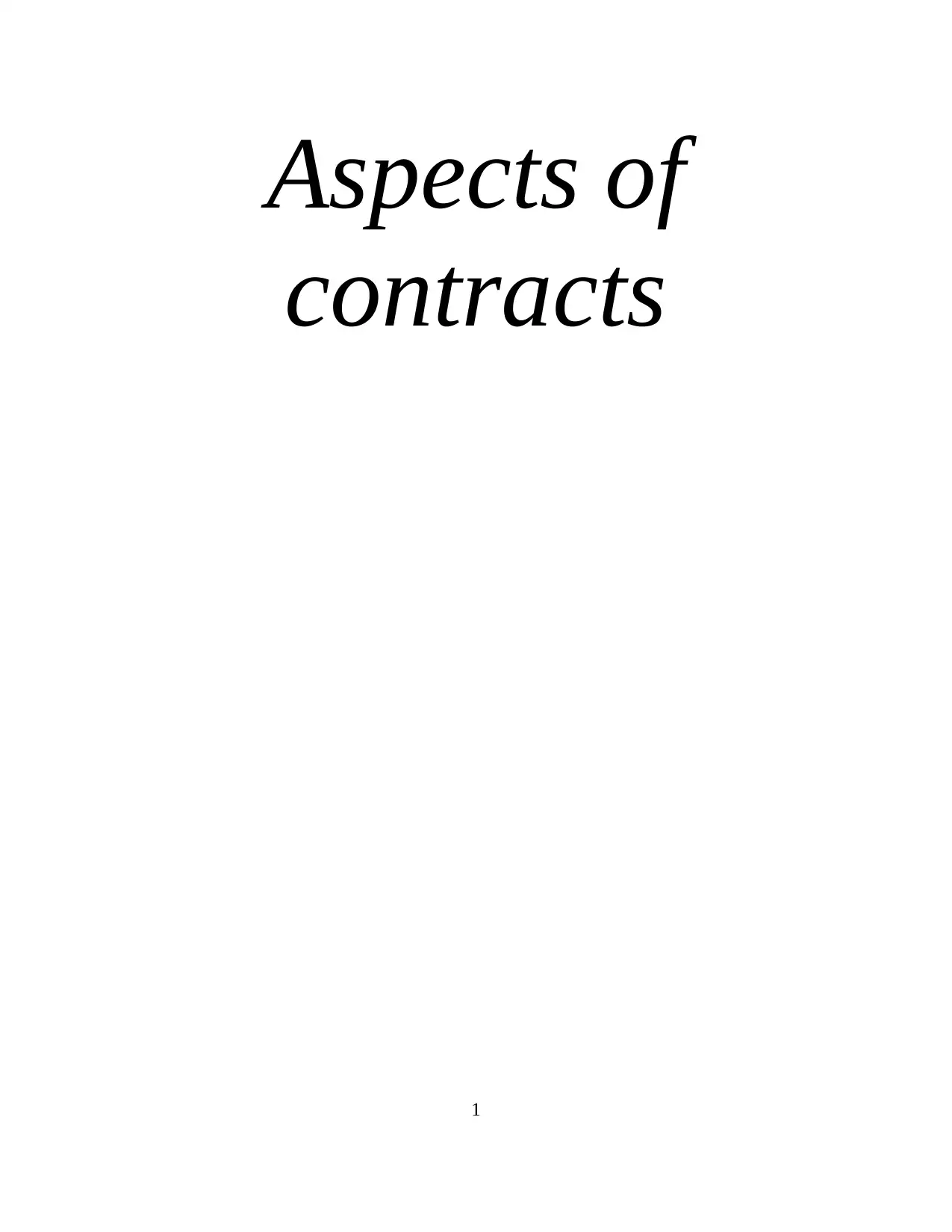
Aspects of
contracts
1
contracts
1
Paraphrase This Document
Need a fresh take? Get an instant paraphrase of this document with our AI Paraphraser
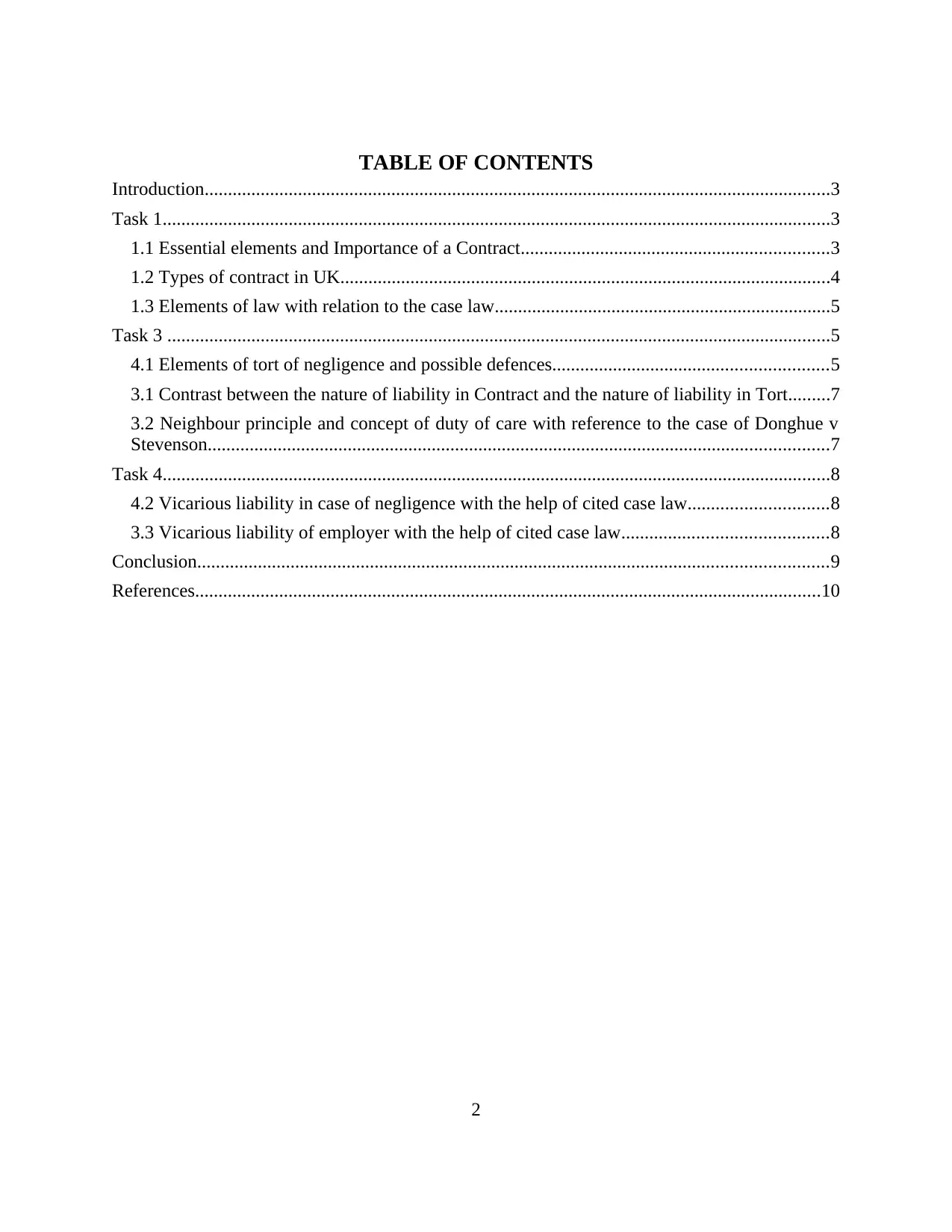
TABLE OF CONTENTS
Introduction......................................................................................................................................3
Task 1...............................................................................................................................................3
1.1 Essential elements and Importance of a Contract..................................................................3
1.2 Types of contract in UK.........................................................................................................4
1.3 Elements of law with relation to the case law........................................................................5
Task 3 ..............................................................................................................................................5
4.1 Elements of tort of negligence and possible defences...........................................................5
3.1 Contrast between the nature of liability in Contract and the nature of liability in Tort.........7
3.2 Neighbour principle and concept of duty of care with reference to the case of Donghue v
Stevenson.....................................................................................................................................7
Task 4...............................................................................................................................................8
4.2 Vicarious liability in case of negligence with the help of cited case law..............................8
3.3 Vicarious liability of employer with the help of cited case law............................................8
Conclusion.......................................................................................................................................9
References......................................................................................................................................10
2
Introduction......................................................................................................................................3
Task 1...............................................................................................................................................3
1.1 Essential elements and Importance of a Contract..................................................................3
1.2 Types of contract in UK.........................................................................................................4
1.3 Elements of law with relation to the case law........................................................................5
Task 3 ..............................................................................................................................................5
4.1 Elements of tort of negligence and possible defences...........................................................5
3.1 Contrast between the nature of liability in Contract and the nature of liability in Tort.........7
3.2 Neighbour principle and concept of duty of care with reference to the case of Donghue v
Stevenson.....................................................................................................................................7
Task 4...............................................................................................................................................8
4.2 Vicarious liability in case of negligence with the help of cited case law..............................8
3.3 Vicarious liability of employer with the help of cited case law............................................8
Conclusion.......................................................................................................................................9
References......................................................................................................................................10
2
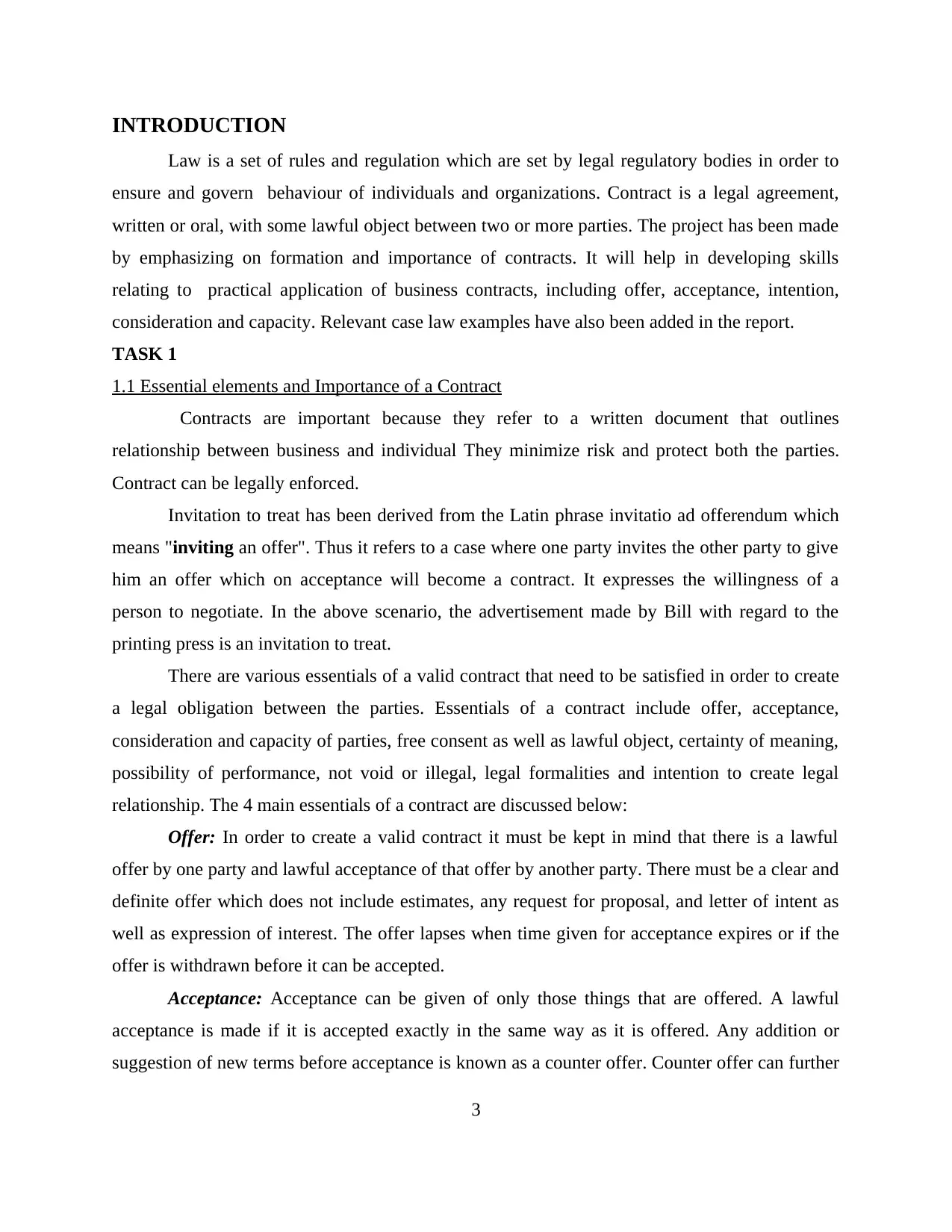
INTRODUCTION
Law is a set of rules and regulation which are set by legal regulatory bodies in order to
ensure and govern behaviour of individuals and organizations. Contract is a legal agreement,
written or oral, with some lawful object between two or more parties. The project has been made
by emphasizing on formation and importance of contracts. It will help in developing skills
relating to practical application of business contracts, including offer, acceptance, intention,
consideration and capacity. Relevant case law examples have also been added in the report.
TASK 1
1.1 Essential elements and Importance of a Contract
Contracts are important because they refer to a written document that outlines
relationship between business and individual They minimize risk and protect both the parties.
Contract can be legally enforced.
Invitation to treat has been derived from the Latin phrase invitatio ad offerendum which
means "inviting an offer". Thus it refers to a case where one party invites the other party to give
him an offer which on acceptance will become a contract. It expresses the willingness of a
person to negotiate. In the above scenario, the advertisement made by Bill with regard to the
printing press is an invitation to treat.
There are various essentials of a valid contract that need to be satisfied in order to create
a legal obligation between the parties. Essentials of a contract include offer, acceptance,
consideration and capacity of parties, free consent as well as lawful object, certainty of meaning,
possibility of performance, not void or illegal, legal formalities and intention to create legal
relationship. The 4 main essentials of a contract are discussed below:
Offer: In order to create a valid contract it must be kept in mind that there is a lawful
offer by one party and lawful acceptance of that offer by another party. There must be a clear and
definite offer which does not include estimates, any request for proposal, and letter of intent as
well as expression of interest. The offer lapses when time given for acceptance expires or if the
offer is withdrawn before it can be accepted.
Acceptance: Acceptance can be given of only those things that are offered. A lawful
acceptance is made if it is accepted exactly in the same way as it is offered. Any addition or
suggestion of new terms before acceptance is known as a counter offer. Counter offer can further
3
Law is a set of rules and regulation which are set by legal regulatory bodies in order to
ensure and govern behaviour of individuals and organizations. Contract is a legal agreement,
written or oral, with some lawful object between two or more parties. The project has been made
by emphasizing on formation and importance of contracts. It will help in developing skills
relating to practical application of business contracts, including offer, acceptance, intention,
consideration and capacity. Relevant case law examples have also been added in the report.
TASK 1
1.1 Essential elements and Importance of a Contract
Contracts are important because they refer to a written document that outlines
relationship between business and individual They minimize risk and protect both the parties.
Contract can be legally enforced.
Invitation to treat has been derived from the Latin phrase invitatio ad offerendum which
means "inviting an offer". Thus it refers to a case where one party invites the other party to give
him an offer which on acceptance will become a contract. It expresses the willingness of a
person to negotiate. In the above scenario, the advertisement made by Bill with regard to the
printing press is an invitation to treat.
There are various essentials of a valid contract that need to be satisfied in order to create
a legal obligation between the parties. Essentials of a contract include offer, acceptance,
consideration and capacity of parties, free consent as well as lawful object, certainty of meaning,
possibility of performance, not void or illegal, legal formalities and intention to create legal
relationship. The 4 main essentials of a contract are discussed below:
Offer: In order to create a valid contract it must be kept in mind that there is a lawful
offer by one party and lawful acceptance of that offer by another party. There must be a clear and
definite offer which does not include estimates, any request for proposal, and letter of intent as
well as expression of interest. The offer lapses when time given for acceptance expires or if the
offer is withdrawn before it can be accepted.
Acceptance: Acceptance can be given of only those things that are offered. A lawful
acceptance is made if it is accepted exactly in the same way as it is offered. Any addition or
suggestion of new terms before acceptance is known as a counter offer. Counter offer can further
3
⊘ This is a preview!⊘
Do you want full access?
Subscribe today to unlock all pages.

Trusted by 1+ million students worldwide
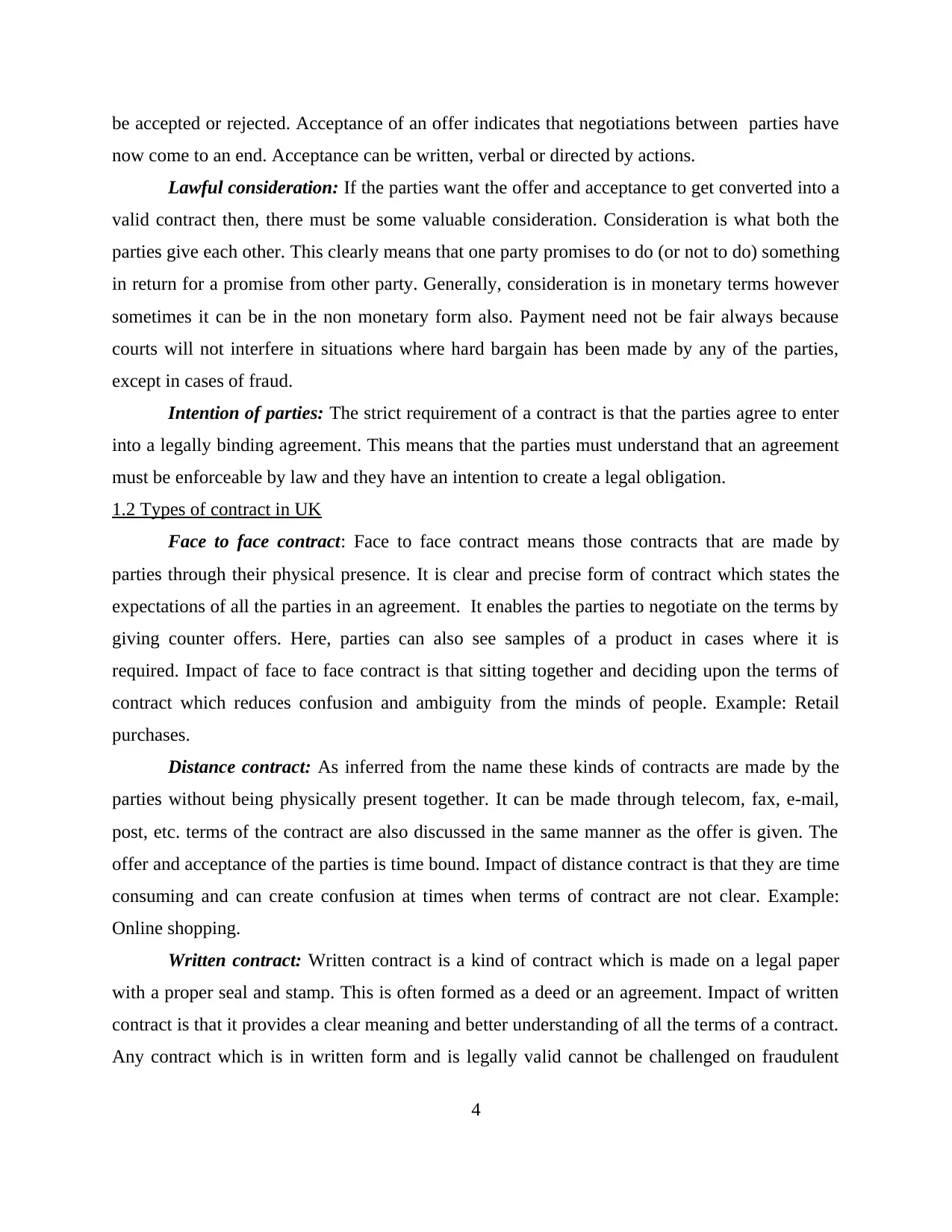
be accepted or rejected. Acceptance of an offer indicates that negotiations between parties have
now come to an end. Acceptance can be written, verbal or directed by actions.
Lawful consideration: If the parties want the offer and acceptance to get converted into a
valid contract then, there must be some valuable consideration. Consideration is what both the
parties give each other. This clearly means that one party promises to do (or not to do) something
in return for a promise from other party. Generally, consideration is in monetary terms however
sometimes it can be in the non monetary form also. Payment need not be fair always because
courts will not interfere in situations where hard bargain has been made by any of the parties,
except in cases of fraud.
Intention of parties: The strict requirement of a contract is that the parties agree to enter
into a legally binding agreement. This means that the parties must understand that an agreement
must be enforceable by law and they have an intention to create a legal obligation.
1.2 Types of contract in UK
Face to face contract: Face to face contract means those contracts that are made by
parties through their physical presence. It is clear and precise form of contract which states the
expectations of all the parties in an agreement. It enables the parties to negotiate on the terms by
giving counter offers. Here, parties can also see samples of a product in cases where it is
required. Impact of face to face contract is that sitting together and deciding upon the terms of
contract which reduces confusion and ambiguity from the minds of people. Example: Retail
purchases.
Distance contract: As inferred from the name these kinds of contracts are made by the
parties without being physically present together. It can be made through telecom, fax, e-mail,
post, etc. terms of the contract are also discussed in the same manner as the offer is given. The
offer and acceptance of the parties is time bound. Impact of distance contract is that they are time
consuming and can create confusion at times when terms of contract are not clear. Example:
Online shopping.
Written contract: Written contract is a kind of contract which is made on a legal paper
with a proper seal and stamp. This is often formed as a deed or an agreement. Impact of written
contract is that it provides a clear meaning and better understanding of all the terms of a contract.
Any contract which is in written form and is legally valid cannot be challenged on fraudulent
4
now come to an end. Acceptance can be written, verbal or directed by actions.
Lawful consideration: If the parties want the offer and acceptance to get converted into a
valid contract then, there must be some valuable consideration. Consideration is what both the
parties give each other. This clearly means that one party promises to do (or not to do) something
in return for a promise from other party. Generally, consideration is in monetary terms however
sometimes it can be in the non monetary form also. Payment need not be fair always because
courts will not interfere in situations where hard bargain has been made by any of the parties,
except in cases of fraud.
Intention of parties: The strict requirement of a contract is that the parties agree to enter
into a legally binding agreement. This means that the parties must understand that an agreement
must be enforceable by law and they have an intention to create a legal obligation.
1.2 Types of contract in UK
Face to face contract: Face to face contract means those contracts that are made by
parties through their physical presence. It is clear and precise form of contract which states the
expectations of all the parties in an agreement. It enables the parties to negotiate on the terms by
giving counter offers. Here, parties can also see samples of a product in cases where it is
required. Impact of face to face contract is that sitting together and deciding upon the terms of
contract which reduces confusion and ambiguity from the minds of people. Example: Retail
purchases.
Distance contract: As inferred from the name these kinds of contracts are made by the
parties without being physically present together. It can be made through telecom, fax, e-mail,
post, etc. terms of the contract are also discussed in the same manner as the offer is given. The
offer and acceptance of the parties is time bound. Impact of distance contract is that they are time
consuming and can create confusion at times when terms of contract are not clear. Example:
Online shopping.
Written contract: Written contract is a kind of contract which is made on a legal paper
with a proper seal and stamp. This is often formed as a deed or an agreement. Impact of written
contract is that it provides a clear meaning and better understanding of all the terms of a contract.
Any contract which is in written form and is legally valid cannot be challenged on fraudulent
4
Paraphrase This Document
Need a fresh take? Get an instant paraphrase of this document with our AI Paraphraser
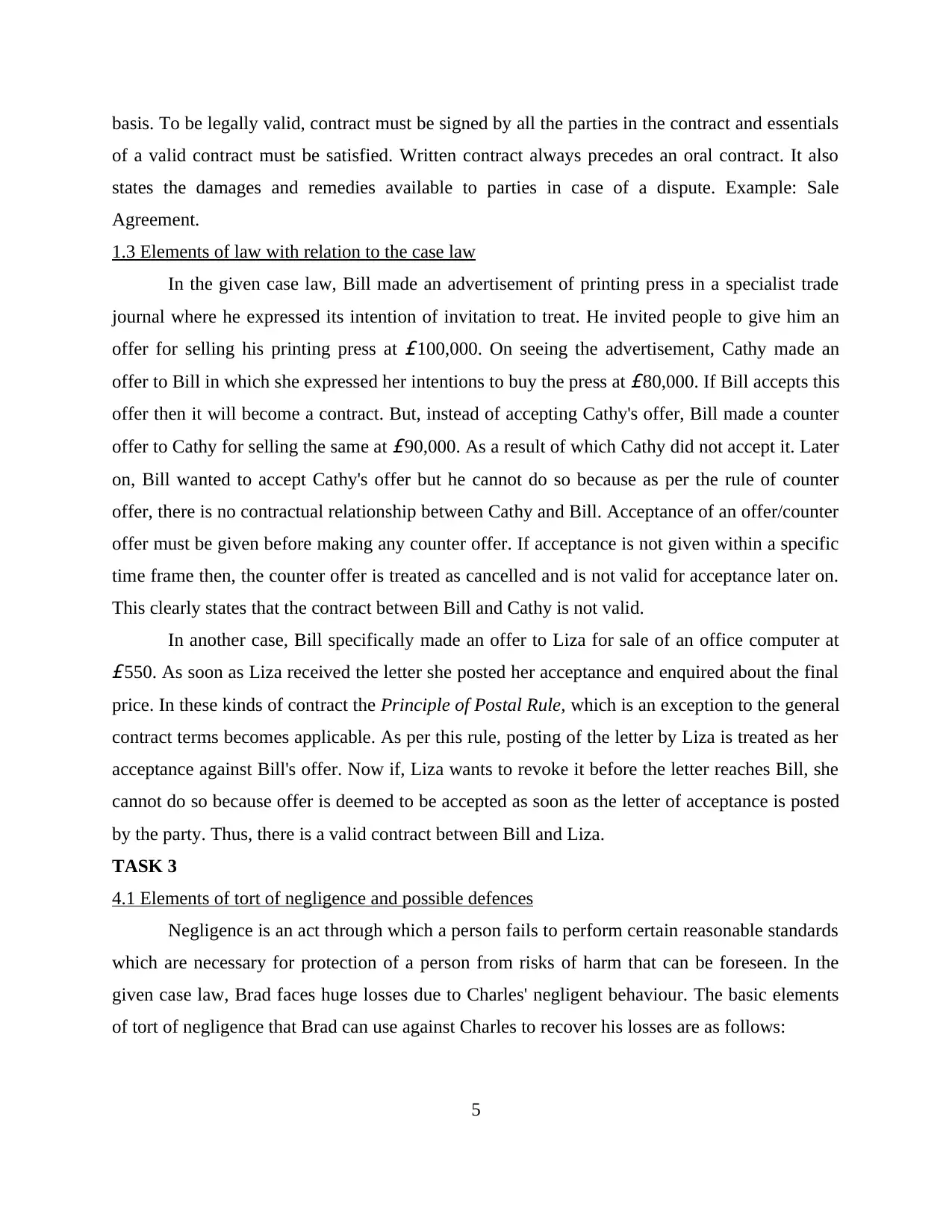
basis. To be legally valid, contract must be signed by all the parties in the contract and essentials
of a valid contract must be satisfied. Written contract always precedes an oral contract. It also
states the damages and remedies available to parties in case of a dispute. Example: Sale
Agreement.
1.3 Elements of law with relation to the case law
In the given case law, Bill made an advertisement of printing press in a specialist trade
journal where he expressed its intention of invitation to treat. He invited people to give him an
offer for selling his printing press at £100,000. On seeing the advertisement, Cathy made an
offer to Bill in which she expressed her intentions to buy the press at £80,000. If Bill accepts this
offer then it will become a contract. But, instead of accepting Cathy's offer, Bill made a counter
offer to Cathy for selling the same at £90,000. As a result of which Cathy did not accept it. Later
on, Bill wanted to accept Cathy's offer but he cannot do so because as per the rule of counter
offer, there is no contractual relationship between Cathy and Bill. Acceptance of an offer/counter
offer must be given before making any counter offer. If acceptance is not given within a specific
time frame then, the counter offer is treated as cancelled and is not valid for acceptance later on.
This clearly states that the contract between Bill and Cathy is not valid.
In another case, Bill specifically made an offer to Liza for sale of an office computer at
£550. As soon as Liza received the letter she posted her acceptance and enquired about the final
price. In these kinds of contract the Principle of Postal Rule, which is an exception to the general
contract terms becomes applicable. As per this rule, posting of the letter by Liza is treated as her
acceptance against Bill's offer. Now if, Liza wants to revoke it before the letter reaches Bill, she
cannot do so because offer is deemed to be accepted as soon as the letter of acceptance is posted
by the party. Thus, there is a valid contract between Bill and Liza.
TASK 3
4.1 Elements of tort of negligence and possible defences
Negligence is an act through which a person fails to perform certain reasonable standards
which are necessary for protection of a person from risks of harm that can be foreseen. In the
given case law, Brad faces huge losses due to Charles' negligent behaviour. The basic elements
of tort of negligence that Brad can use against Charles to recover his losses are as follows:
5
of a valid contract must be satisfied. Written contract always precedes an oral contract. It also
states the damages and remedies available to parties in case of a dispute. Example: Sale
Agreement.
1.3 Elements of law with relation to the case law
In the given case law, Bill made an advertisement of printing press in a specialist trade
journal where he expressed its intention of invitation to treat. He invited people to give him an
offer for selling his printing press at £100,000. On seeing the advertisement, Cathy made an
offer to Bill in which she expressed her intentions to buy the press at £80,000. If Bill accepts this
offer then it will become a contract. But, instead of accepting Cathy's offer, Bill made a counter
offer to Cathy for selling the same at £90,000. As a result of which Cathy did not accept it. Later
on, Bill wanted to accept Cathy's offer but he cannot do so because as per the rule of counter
offer, there is no contractual relationship between Cathy and Bill. Acceptance of an offer/counter
offer must be given before making any counter offer. If acceptance is not given within a specific
time frame then, the counter offer is treated as cancelled and is not valid for acceptance later on.
This clearly states that the contract between Bill and Cathy is not valid.
In another case, Bill specifically made an offer to Liza for sale of an office computer at
£550. As soon as Liza received the letter she posted her acceptance and enquired about the final
price. In these kinds of contract the Principle of Postal Rule, which is an exception to the general
contract terms becomes applicable. As per this rule, posting of the letter by Liza is treated as her
acceptance against Bill's offer. Now if, Liza wants to revoke it before the letter reaches Bill, she
cannot do so because offer is deemed to be accepted as soon as the letter of acceptance is posted
by the party. Thus, there is a valid contract between Bill and Liza.
TASK 3
4.1 Elements of tort of negligence and possible defences
Negligence is an act through which a person fails to perform certain reasonable standards
which are necessary for protection of a person from risks of harm that can be foreseen. In the
given case law, Brad faces huge losses due to Charles' negligent behaviour. The basic elements
of tort of negligence that Brad can use against Charles to recover his losses are as follows:
5
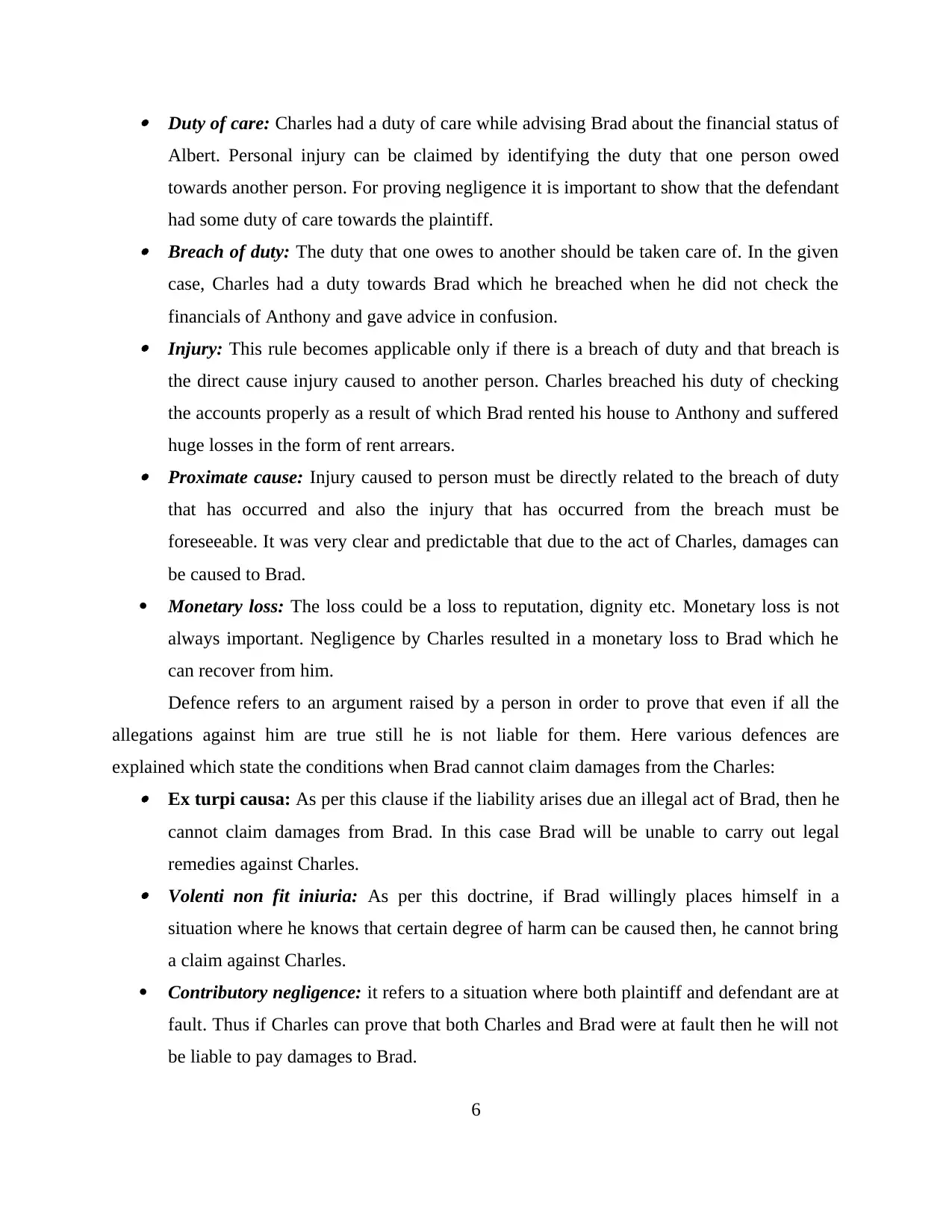
Duty of care: Charles had a duty of care while advising Brad about the financial status of
Albert. Personal injury can be claimed by identifying the duty that one person owed
towards another person. For proving negligence it is important to show that the defendant
had some duty of care towards the plaintiff. Breach of duty: The duty that one owes to another should be taken care of. In the given
case, Charles had a duty towards Brad which he breached when he did not check the
financials of Anthony and gave advice in confusion. Injury: This rule becomes applicable only if there is a breach of duty and that breach is
the direct cause injury caused to another person. Charles breached his duty of checking
the accounts properly as a result of which Brad rented his house to Anthony and suffered
huge losses in the form of rent arrears. Proximate cause: Injury caused to person must be directly related to the breach of duty
that has occurred and also the injury that has occurred from the breach must be
foreseeable. It was very clear and predictable that due to the act of Charles, damages can
be caused to Brad.
Monetary loss: The loss could be a loss to reputation, dignity etc. Monetary loss is not
always important. Negligence by Charles resulted in a monetary loss to Brad which he
can recover from him.
Defence refers to an argument raised by a person in order to prove that even if all the
allegations against him are true still he is not liable for them. Here various defences are
explained which state the conditions when Brad cannot claim damages from the Charles: Ex turpi causa: As per this clause if the liability arises due an illegal act of Brad, then he
cannot claim damages from Brad. In this case Brad will be unable to carry out legal
remedies against Charles. Volenti non fit iniuria: As per this doctrine, if Brad willingly places himself in a
situation where he knows that certain degree of harm can be caused then, he cannot bring
a claim against Charles.
Contributory negligence: it refers to a situation where both plaintiff and defendant are at
fault. Thus if Charles can prove that both Charles and Brad were at fault then he will not
be liable to pay damages to Brad.
6
Albert. Personal injury can be claimed by identifying the duty that one person owed
towards another person. For proving negligence it is important to show that the defendant
had some duty of care towards the plaintiff. Breach of duty: The duty that one owes to another should be taken care of. In the given
case, Charles had a duty towards Brad which he breached when he did not check the
financials of Anthony and gave advice in confusion. Injury: This rule becomes applicable only if there is a breach of duty and that breach is
the direct cause injury caused to another person. Charles breached his duty of checking
the accounts properly as a result of which Brad rented his house to Anthony and suffered
huge losses in the form of rent arrears. Proximate cause: Injury caused to person must be directly related to the breach of duty
that has occurred and also the injury that has occurred from the breach must be
foreseeable. It was very clear and predictable that due to the act of Charles, damages can
be caused to Brad.
Monetary loss: The loss could be a loss to reputation, dignity etc. Monetary loss is not
always important. Negligence by Charles resulted in a monetary loss to Brad which he
can recover from him.
Defence refers to an argument raised by a person in order to prove that even if all the
allegations against him are true still he is not liable for them. Here various defences are
explained which state the conditions when Brad cannot claim damages from the Charles: Ex turpi causa: As per this clause if the liability arises due an illegal act of Brad, then he
cannot claim damages from Brad. In this case Brad will be unable to carry out legal
remedies against Charles. Volenti non fit iniuria: As per this doctrine, if Brad willingly places himself in a
situation where he knows that certain degree of harm can be caused then, he cannot bring
a claim against Charles.
Contributory negligence: it refers to a situation where both plaintiff and defendant are at
fault. Thus if Charles can prove that both Charles and Brad were at fault then he will not
be liable to pay damages to Brad.
6
⊘ This is a preview!⊘
Do you want full access?
Subscribe today to unlock all pages.

Trusted by 1+ million students worldwide
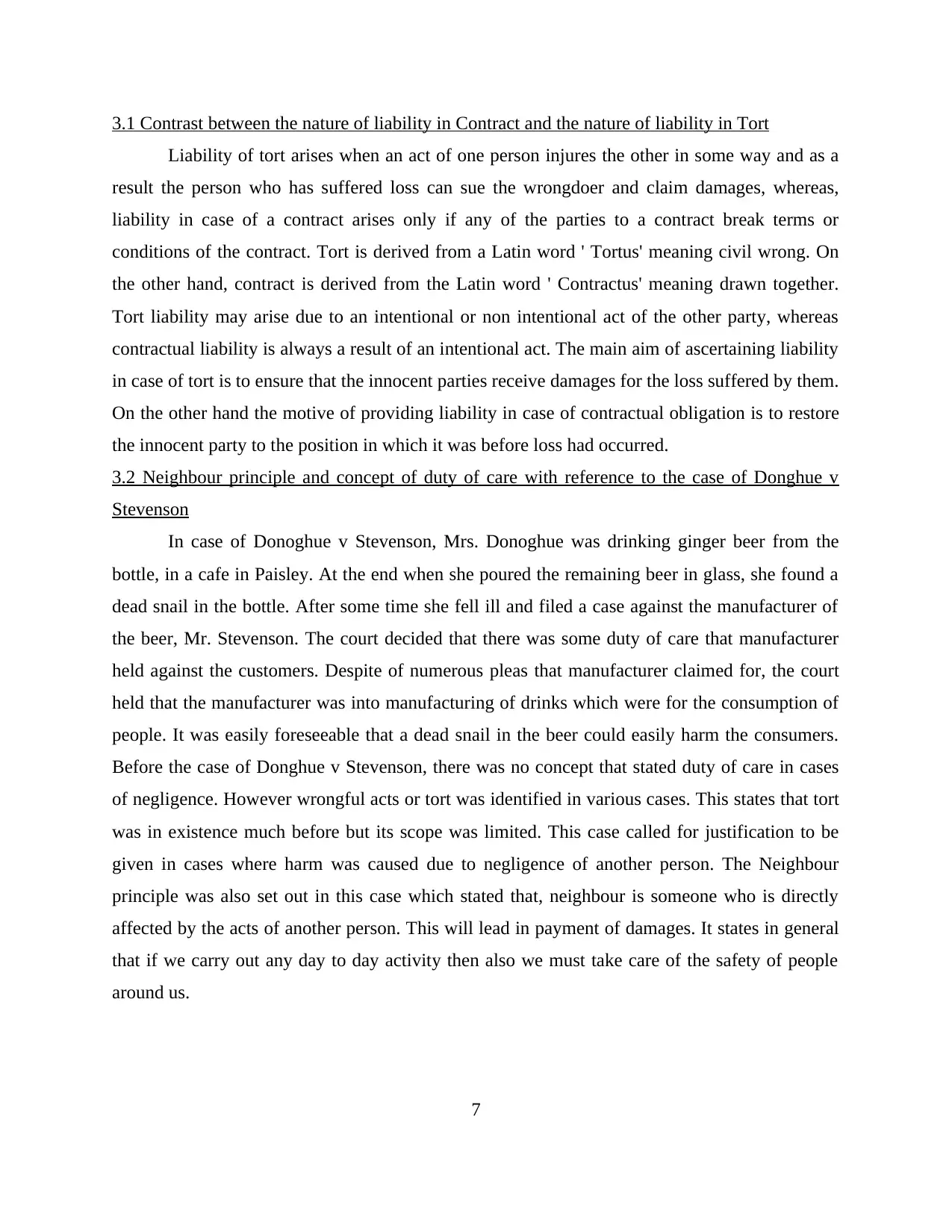
3.1 Contrast between the nature of liability in Contract and the nature of liability in Tort
Liability of tort arises when an act of one person injures the other in some way and as a
result the person who has suffered loss can sue the wrongdoer and claim damages, whereas,
liability in case of a contract arises only if any of the parties to a contract break terms or
conditions of the contract. Tort is derived from a Latin word ' Tortus' meaning civil wrong. On
the other hand, contract is derived from the Latin word ' Contractus' meaning drawn together.
Tort liability may arise due to an intentional or non intentional act of the other party, whereas
contractual liability is always a result of an intentional act. The main aim of ascertaining liability
in case of tort is to ensure that the innocent parties receive damages for the loss suffered by them.
On the other hand the motive of providing liability in case of contractual obligation is to restore
the innocent party to the position in which it was before loss had occurred.
3.2 Neighbour principle and concept of duty of care with reference to the case of Donghue v
Stevenson
In case of Donoghue v Stevenson, Mrs. Donoghue was drinking ginger beer from the
bottle, in a cafe in Paisley. At the end when she poured the remaining beer in glass, she found a
dead snail in the bottle. After some time she fell ill and filed a case against the manufacturer of
the beer, Mr. Stevenson. The court decided that there was some duty of care that manufacturer
held against the customers. Despite of numerous pleas that manufacturer claimed for, the court
held that the manufacturer was into manufacturing of drinks which were for the consumption of
people. It was easily foreseeable that a dead snail in the beer could easily harm the consumers.
Before the case of Donghue v Stevenson, there was no concept that stated duty of care in cases
of negligence. However wrongful acts or tort was identified in various cases. This states that tort
was in existence much before but its scope was limited. This case called for justification to be
given in cases where harm was caused due to negligence of another person. The Neighbour
principle was also set out in this case which stated that, neighbour is someone who is directly
affected by the acts of another person. This will lead in payment of damages. It states in general
that if we carry out any day to day activity then also we must take care of the safety of people
around us.
7
Liability of tort arises when an act of one person injures the other in some way and as a
result the person who has suffered loss can sue the wrongdoer and claim damages, whereas,
liability in case of a contract arises only if any of the parties to a contract break terms or
conditions of the contract. Tort is derived from a Latin word ' Tortus' meaning civil wrong. On
the other hand, contract is derived from the Latin word ' Contractus' meaning drawn together.
Tort liability may arise due to an intentional or non intentional act of the other party, whereas
contractual liability is always a result of an intentional act. The main aim of ascertaining liability
in case of tort is to ensure that the innocent parties receive damages for the loss suffered by them.
On the other hand the motive of providing liability in case of contractual obligation is to restore
the innocent party to the position in which it was before loss had occurred.
3.2 Neighbour principle and concept of duty of care with reference to the case of Donghue v
Stevenson
In case of Donoghue v Stevenson, Mrs. Donoghue was drinking ginger beer from the
bottle, in a cafe in Paisley. At the end when she poured the remaining beer in glass, she found a
dead snail in the bottle. After some time she fell ill and filed a case against the manufacturer of
the beer, Mr. Stevenson. The court decided that there was some duty of care that manufacturer
held against the customers. Despite of numerous pleas that manufacturer claimed for, the court
held that the manufacturer was into manufacturing of drinks which were for the consumption of
people. It was easily foreseeable that a dead snail in the beer could easily harm the consumers.
Before the case of Donghue v Stevenson, there was no concept that stated duty of care in cases
of negligence. However wrongful acts or tort was identified in various cases. This states that tort
was in existence much before but its scope was limited. This case called for justification to be
given in cases where harm was caused due to negligence of another person. The Neighbour
principle was also set out in this case which stated that, neighbour is someone who is directly
affected by the acts of another person. This will lead in payment of damages. It states in general
that if we carry out any day to day activity then also we must take care of the safety of people
around us.
7
Paraphrase This Document
Need a fresh take? Get an instant paraphrase of this document with our AI Paraphraser
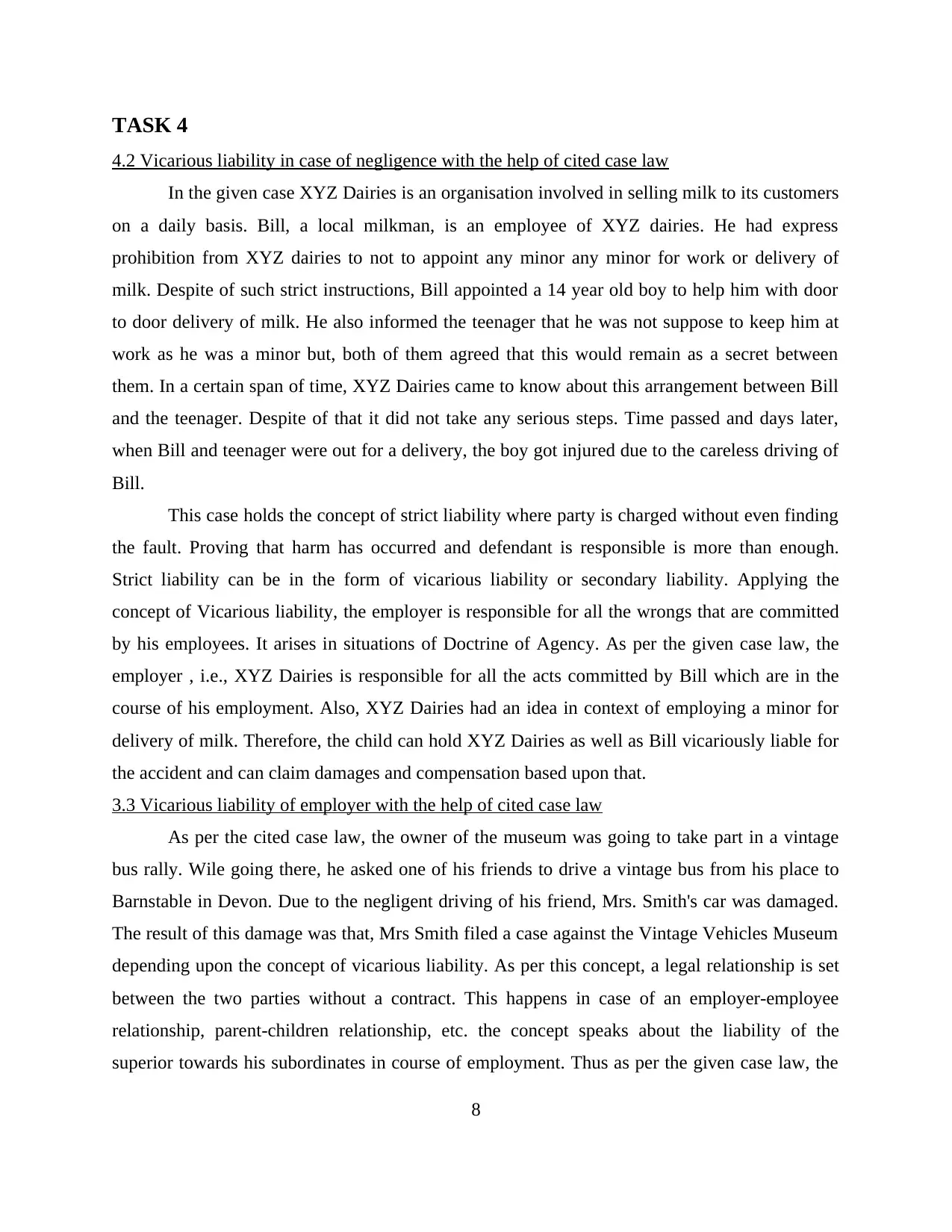
TASK 4
4.2 Vicarious liability in case of negligence with the help of cited case law
In the given case XYZ Dairies is an organisation involved in selling milk to its customers
on a daily basis. Bill, a local milkman, is an employee of XYZ dairies. He had express
prohibition from XYZ dairies to not to appoint any minor any minor for work or delivery of
milk. Despite of such strict instructions, Bill appointed a 14 year old boy to help him with door
to door delivery of milk. He also informed the teenager that he was not suppose to keep him at
work as he was a minor but, both of them agreed that this would remain as a secret between
them. In a certain span of time, XYZ Dairies came to know about this arrangement between Bill
and the teenager. Despite of that it did not take any serious steps. Time passed and days later,
when Bill and teenager were out for a delivery, the boy got injured due to the careless driving of
Bill.
This case holds the concept of strict liability where party is charged without even finding
the fault. Proving that harm has occurred and defendant is responsible is more than enough.
Strict liability can be in the form of vicarious liability or secondary liability. Applying the
concept of Vicarious liability, the employer is responsible for all the wrongs that are committed
by his employees. It arises in situations of Doctrine of Agency. As per the given case law, the
employer , i.e., XYZ Dairies is responsible for all the acts committed by Bill which are in the
course of his employment. Also, XYZ Dairies had an idea in context of employing a minor for
delivery of milk. Therefore, the child can hold XYZ Dairies as well as Bill vicariously liable for
the accident and can claim damages and compensation based upon that.
3.3 Vicarious liability of employer with the help of cited case law
As per the cited case law, the owner of the museum was going to take part in a vintage
bus rally. Wile going there, he asked one of his friends to drive a vintage bus from his place to
Barnstable in Devon. Due to the negligent driving of his friend, Mrs. Smith's car was damaged.
The result of this damage was that, Mrs Smith filed a case against the Vintage Vehicles Museum
depending upon the concept of vicarious liability. As per this concept, a legal relationship is set
between the two parties without a contract. This happens in case of an employer-employee
relationship, parent-children relationship, etc. the concept speaks about the liability of the
superior towards his subordinates in course of employment. Thus as per the given case law, the
8
4.2 Vicarious liability in case of negligence with the help of cited case law
In the given case XYZ Dairies is an organisation involved in selling milk to its customers
on a daily basis. Bill, a local milkman, is an employee of XYZ dairies. He had express
prohibition from XYZ dairies to not to appoint any minor any minor for work or delivery of
milk. Despite of such strict instructions, Bill appointed a 14 year old boy to help him with door
to door delivery of milk. He also informed the teenager that he was not suppose to keep him at
work as he was a minor but, both of them agreed that this would remain as a secret between
them. In a certain span of time, XYZ Dairies came to know about this arrangement between Bill
and the teenager. Despite of that it did not take any serious steps. Time passed and days later,
when Bill and teenager were out for a delivery, the boy got injured due to the careless driving of
Bill.
This case holds the concept of strict liability where party is charged without even finding
the fault. Proving that harm has occurred and defendant is responsible is more than enough.
Strict liability can be in the form of vicarious liability or secondary liability. Applying the
concept of Vicarious liability, the employer is responsible for all the wrongs that are committed
by his employees. It arises in situations of Doctrine of Agency. As per the given case law, the
employer , i.e., XYZ Dairies is responsible for all the acts committed by Bill which are in the
course of his employment. Also, XYZ Dairies had an idea in context of employing a minor for
delivery of milk. Therefore, the child can hold XYZ Dairies as well as Bill vicariously liable for
the accident and can claim damages and compensation based upon that.
3.3 Vicarious liability of employer with the help of cited case law
As per the cited case law, the owner of the museum was going to take part in a vintage
bus rally. Wile going there, he asked one of his friends to drive a vintage bus from his place to
Barnstable in Devon. Due to the negligent driving of his friend, Mrs. Smith's car was damaged.
The result of this damage was that, Mrs Smith filed a case against the Vintage Vehicles Museum
depending upon the concept of vicarious liability. As per this concept, a legal relationship is set
between the two parties without a contract. This happens in case of an employer-employee
relationship, parent-children relationship, etc. the concept speaks about the liability of the
superior towards his subordinates in course of employment. Thus as per the given case law, the
8
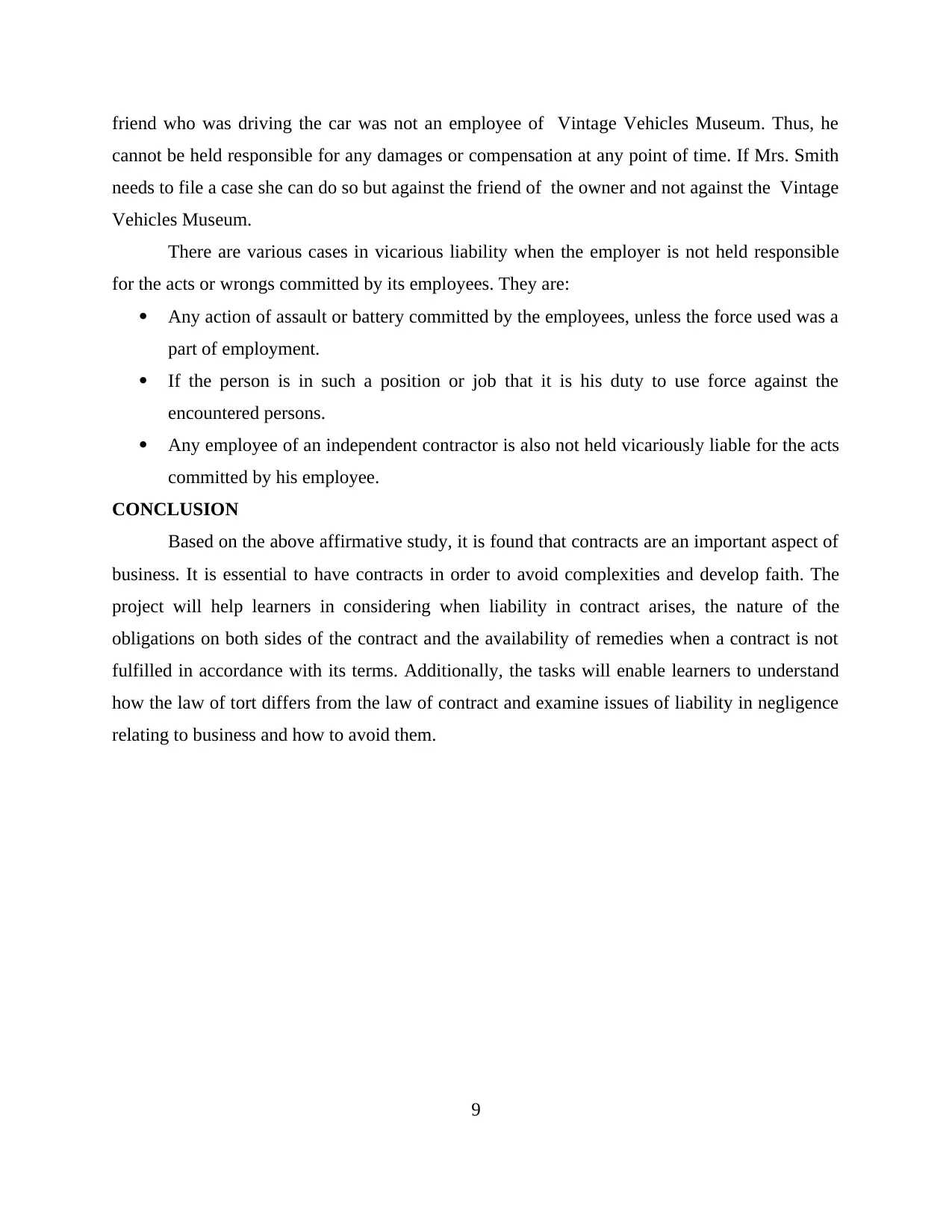
friend who was driving the car was not an employee of Vintage Vehicles Museum. Thus, he
cannot be held responsible for any damages or compensation at any point of time. If Mrs. Smith
needs to file a case she can do so but against the friend of the owner and not against the Vintage
Vehicles Museum.
There are various cases in vicarious liability when the employer is not held responsible
for the acts or wrongs committed by its employees. They are:
Any action of assault or battery committed by the employees, unless the force used was a
part of employment.
If the person is in such a position or job that it is his duty to use force against the
encountered persons.
Any employee of an independent contractor is also not held vicariously liable for the acts
committed by his employee.
CONCLUSION
Based on the above affirmative study, it is found that contracts are an important aspect of
business. It is essential to have contracts in order to avoid complexities and develop faith. The
project will help learners in considering when liability in contract arises, the nature of the
obligations on both sides of the contract and the availability of remedies when a contract is not
fulfilled in accordance with its terms. Additionally, the tasks will enable learners to understand
how the law of tort differs from the law of contract and examine issues of liability in negligence
relating to business and how to avoid them.
9
cannot be held responsible for any damages or compensation at any point of time. If Mrs. Smith
needs to file a case she can do so but against the friend of the owner and not against the Vintage
Vehicles Museum.
There are various cases in vicarious liability when the employer is not held responsible
for the acts or wrongs committed by its employees. They are:
Any action of assault or battery committed by the employees, unless the force used was a
part of employment.
If the person is in such a position or job that it is his duty to use force against the
encountered persons.
Any employee of an independent contractor is also not held vicariously liable for the acts
committed by his employee.
CONCLUSION
Based on the above affirmative study, it is found that contracts are an important aspect of
business. It is essential to have contracts in order to avoid complexities and develop faith. The
project will help learners in considering when liability in contract arises, the nature of the
obligations on both sides of the contract and the availability of remedies when a contract is not
fulfilled in accordance with its terms. Additionally, the tasks will enable learners to understand
how the law of tort differs from the law of contract and examine issues of liability in negligence
relating to business and how to avoid them.
9
⊘ This is a preview!⊘
Do you want full access?
Subscribe today to unlock all pages.

Trusted by 1+ million students worldwide
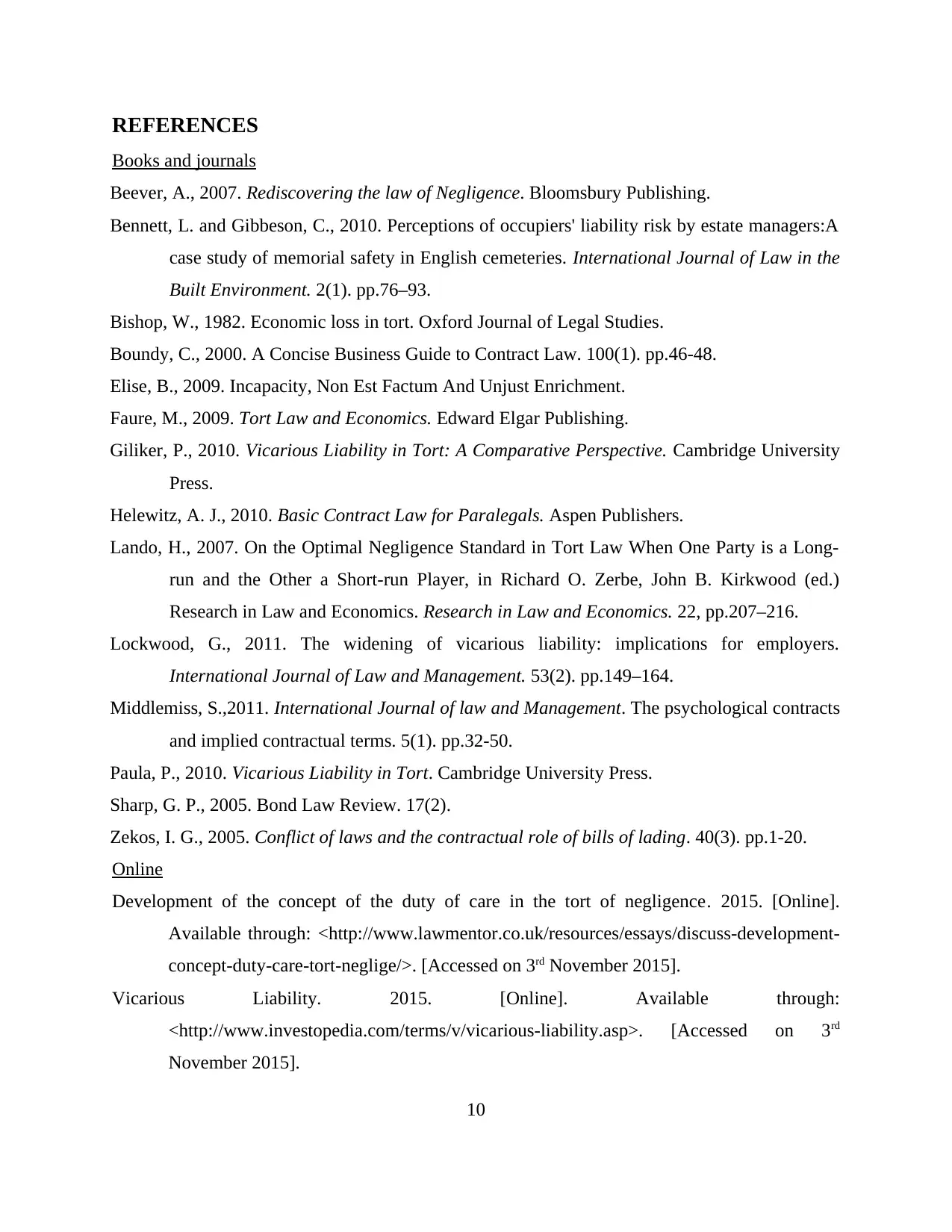
REFERENCES
Books and journals
Beever, A., 2007. Rediscovering the law of Negligence. Bloomsbury Publishing.
Bennett, L. and Gibbeson, C., 2010. Perceptions of occupiers' liability risk by estate managers:A
case study of memorial safety in English cemeteries. International Journal of Law in the
Built Environment. 2(1). pp.76–93.
Bishop, W., 1982. Economic loss in tort. Oxford Journal of Legal Studies.
Boundy, C., 2000. A Concise Business Guide to Contract Law. 100(1). pp.46-48.
Elise, B., 2009. Incapacity, Non Est Factum And Unjust Enrichment.
Faure, M., 2009. Tort Law and Economics. Edward Elgar Publishing.
Giliker, P., 2010. Vicarious Liability in Tort: A Comparative Perspective. Cambridge University
Press.
Helewitz, A. J., 2010. Basic Contract Law for Paralegals. Aspen Publishers.
Lando, H., 2007. On the Optimal Negligence Standard in Tort Law When One Party is a Long-
run and the Other a Short-run Player, in Richard O. Zerbe, John B. Kirkwood (ed.)
Research in Law and Economics. Research in Law and Economics. 22, pp.207–216.
Lockwood, G., 2011. The widening of vicarious liability: implications for employers.
International Journal of Law and Management. 53(2). pp.149–164.
Middlemiss, S.,2011. International Journal of law and Management. The psychological contracts
and implied contractual terms. 5(1). pp.32-50.
Paula, P., 2010. Vicarious Liability in Tort. Cambridge University Press.
Sharp, G. P., 2005. Bond Law Review. 17(2).
Zekos, I. G., 2005. Conflict of laws and the contractual role of bills of lading. 40(3). pp.1-20.
Online
Development of the concept of the duty of care in the tort of negligence. 2015. [Online].
Available through: <http://www.lawmentor.co.uk/resources/essays/discuss-development-
concept-duty-care-tort-neglige/>. [Accessed on 3rd November 2015].
Vicarious Liability. 2015. [Online]. Available through:
<http://www.investopedia.com/terms/v/vicarious-liability.asp>. [Accessed on 3rd
November 2015].
10
Books and journals
Beever, A., 2007. Rediscovering the law of Negligence. Bloomsbury Publishing.
Bennett, L. and Gibbeson, C., 2010. Perceptions of occupiers' liability risk by estate managers:A
case study of memorial safety in English cemeteries. International Journal of Law in the
Built Environment. 2(1). pp.76–93.
Bishop, W., 1982. Economic loss in tort. Oxford Journal of Legal Studies.
Boundy, C., 2000. A Concise Business Guide to Contract Law. 100(1). pp.46-48.
Elise, B., 2009. Incapacity, Non Est Factum And Unjust Enrichment.
Faure, M., 2009. Tort Law and Economics. Edward Elgar Publishing.
Giliker, P., 2010. Vicarious Liability in Tort: A Comparative Perspective. Cambridge University
Press.
Helewitz, A. J., 2010. Basic Contract Law for Paralegals. Aspen Publishers.
Lando, H., 2007. On the Optimal Negligence Standard in Tort Law When One Party is a Long-
run and the Other a Short-run Player, in Richard O. Zerbe, John B. Kirkwood (ed.)
Research in Law and Economics. Research in Law and Economics. 22, pp.207–216.
Lockwood, G., 2011. The widening of vicarious liability: implications for employers.
International Journal of Law and Management. 53(2). pp.149–164.
Middlemiss, S.,2011. International Journal of law and Management. The psychological contracts
and implied contractual terms. 5(1). pp.32-50.
Paula, P., 2010. Vicarious Liability in Tort. Cambridge University Press.
Sharp, G. P., 2005. Bond Law Review. 17(2).
Zekos, I. G., 2005. Conflict of laws and the contractual role of bills of lading. 40(3). pp.1-20.
Online
Development of the concept of the duty of care in the tort of negligence. 2015. [Online].
Available through: <http://www.lawmentor.co.uk/resources/essays/discuss-development-
concept-duty-care-tort-neglige/>. [Accessed on 3rd November 2015].
Vicarious Liability. 2015. [Online]. Available through:
<http://www.investopedia.com/terms/v/vicarious-liability.asp>. [Accessed on 3rd
November 2015].
10
Paraphrase This Document
Need a fresh take? Get an instant paraphrase of this document with our AI Paraphraser

e-lawresources.co.uk. 2015. [Online]. Available
through<http://e-lawresources.co.uk/Contract.php>. [Accessed on 3rd November 2015].
11
through<http://e-lawresources.co.uk/Contract.php>. [Accessed on 3rd November 2015].
11
1 out of 11
Related Documents
Your All-in-One AI-Powered Toolkit for Academic Success.
+13062052269
info@desklib.com
Available 24*7 on WhatsApp / Email
![[object Object]](/_next/static/media/star-bottom.7253800d.svg)
Unlock your academic potential
Copyright © 2020–2025 A2Z Services. All Rights Reserved. Developed and managed by ZUCOL.





